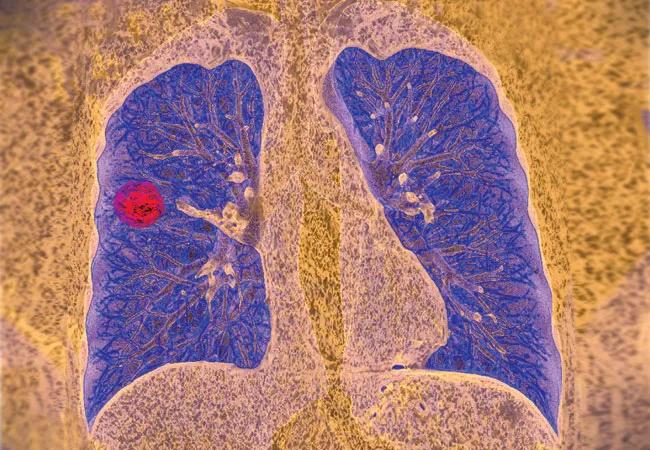Resection, radiotherapy or ablation?

Lobectomy, a standard treatment for patients with stage 1 non-small cell lung cancer (NSCLC), is not advised for people with high risk of postsurgical complications or mortality. That includes people with severe frailty, low diffusion capacity or supplemental oxygen use due to other lung disease. The American Association for Thoracic Surgery (AATS) published a consensus statement defining and outlining proper assessment of these high-risk patients in 2021.
Advertisement
Cleveland Clinic is a non-profit academic medical center. Advertising on our site helps support our mission. We do not endorse non-Cleveland Clinic products or services. Policy
In late 2024, AATS published a follow-up document: consensus on how to choose more appropriate treatment for high-risk patients. Alternatives to lobectomy include sublobar resection, stereotactic ablative radiotherapy (SABR) and image-guided thermal ablation (IGTA).
“We have a variety of tools for treating stage 1 NSCLC, but selecting the best one isn’t always straightforward,” says Sudish Murthy, MD, PhD, Section Head of Thoracic Surgery at Cleveland Clinic. “One thing is clear, however: We need to treat these patients quickly and confidently. Many studies indicate poor outcomes when treatment is delayed or the patient isn’t treated at all.”
While multiple professional organizations — such as the American College of Chest Physicians, Society of Interventional Radiology and American Society of Clinical Oncology — have published guidelines for treating high-risk patients with stage 1 NSCLC, the recommendations have varied.
“It was time for AATS to convene its experts and clearly outline guidance for treating these patients,” says Peter Mazzone, MD, MPH, Director of the Lung Cancer Program in Cleveland Clinic’s Department of Pulmonary Medicine.
Both Drs. Murthy and Mazzone were members of the AATS Clinical Practice Standards Committee that wrote the 2024 consensus statement. It was published in a special issue of Seminars in Thoracic and Cardiovascular Surgery.
Based on a literature review, the AATS committee concluded that when lobectomy is not advised, sublobar resection is preferred if it is technically feasible and there are no contraindications to surgery (such as significantly reduced cardiopulmonary function).
Advertisement
When performing sublobar resection, important factors include:
Adequate tumor margins. Various studies report that adequate margins are associated with lower rate of NSCLC recurrence and better outcomes. Because larger tumors and tumors located near bronchovascular structures may not allow for sufficient margins, sublobar resection may not be preferable in these cases.
Lymph node biopsy. Sampling or dissecting lymph nodes helps stage NSCLC more accurately and guide decisions about adjuvant therapy. Overall and recurrence-free survival of patients with sublobar resection and lymph node sampling is similar to that of patients having lobectomy, according to several studies.
When a patient is not a candidate for sublobar resection, SABR can be an effective nonsurgical option. However, care must be taken in patients with large, multifocal or centrally located tumors, where radiation-induced toxicity is a concern. Thoracic surgeons and radiation oncologists can work together to modify treatments (e.g., plan fractionated dosing) and refine treatment targets to help reduce toxicity risk.
When surgery and radiation therapy are not advised, IGTA can be effective for patients with small, peripheral lung lesions. Radiofrequency ablation and microwave ablation are common modalities.
“Ablative technologies continue to evolve, providing more options for patients, including those for whom other therapies have been ineffective,” Dr. Mazzone says. “Combination therapy — such as combining IGTA with radiotherapy — may help control refractory disease.”
Advertisement
While the committee recommends these basic guidelines, treatment selection is a complex process. In addition to tumor-specific factors, patient-specific factors (e.g., age, comorbidities, preferences) help guide decision-making.
For example, multiple research studies show that survival outcomes after sublobar resection are similar to lobectomy for patients over age 70 and patients with peripheral tumors smaller than 2 cm in diameter. In addition, patients with significant underlying interstitial lung disease have higher mortality when their NSCLC is treated with SABR versus radiofrequency ablation.
To illustrate the unique considerations in each patient case, the committee included five clinical vignettes in their consensus statement, highlighting their suggested treatments.
“Above all, we must remember to include the patient in decision-making, explaining the benefits and risks of treatment options,” Dr. Murthy says. “Patients have varying values and preferences for the outcomes of treatment. Some prioritize disease-free survival while others prioritize their independence or quality of life. All of that must go into the equation.”
Concludes Dr. Mazzone, “Institutional experience is another important factor in choosing treatments. At large centers like Cleveland Clinic, where all treatment options are available, we rely on multidisciplinary discussion to make an expert recommendation.”
Advertisement
Advertisement

Treatment assigned FDA review date in June 2025

Cleveland Clinic, the University of Minnesota and University of Cambridge receive $1M grant to develop point-of-care biosensor for early detection and treatment personalization

Hybrid treatment model helps improve cancer care access

Extent of baseline burden impacts progression-free and overall survival

Quantum computing being studied as a means to help improve predictive performance, accuracy

Young age, solid tumor, high uptake on PET and KRAS mutation signal risk, suggest need for lobectomy

Targeting DNMT1 shows promise in chemotherapy- and immunotherapy-resistant SCLC

New review published in Cancers suggests a synergistic benefit